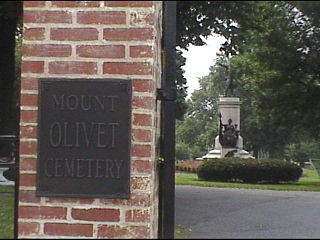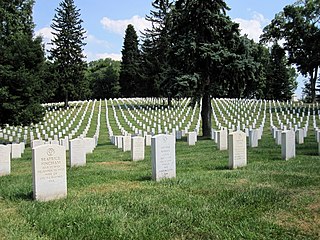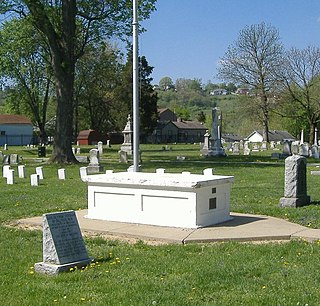
Nelson's Column is a monument in Trafalgar Square in the City of Westminster, Central London, built to commemorate Vice-Admiral Horatio Nelson's decisive victory at the Battle of Trafalgar over the combined French and Spanish navies, during which he lost his life. The monument was constructed between 1840 and 1843 to a design by William Railton at a cost of £47,000. It is a column of the Corinthian order built from Dartmoor granite. The statue of Nelson was carved from Craigleith sandstone by sculptor Edward Hodges Baily. The four bronze lions around its base, designed by Sir Edwin Landseer, were added in 1867.

Laurel Hill Cemetery is a historic rural cemetery in the East Falls neighborhood of Philadelphia. Founded in 1836, it was the second major rural cemetery in the United States after Mount Auburn Cemetery in Boston, Massachusetts.

Mount Olivet Cemetery is a cemetery in Frederick, Maryland. The cemetery is located at 515 South Market Street and is operated by the Mount Olivet Cemetery Company, Inc.

Culpeper National Cemetery is a United States National Cemetery located in the town of Culpeper, in Culpeper County, Virginia. Administered by the United States Department of Veterans Affairs, it encompasses 29.6 acres (120,000 m2) of land, and as 2021, had over 14,000 interments.

The Dauphin County Veteran's Memorial Obelisk, sometimes called the Harrisburg Obelisk, is an Egyptian-style obelisk that was erected in Harrisburg, Pennsylvania as a tribute to Dauphin County’s Civil War soldiers. Designed by civil engineer E. Hudson Worrall, its planning, development and dedication phases were supervised by the Dauphin County Soldiers' Monument Association, which was formed by an act of the Pennsylvania General Assembly on January 30, 1867.

The Grand Army of the Republic Monument, in the Linden Grove Cemetery of Covington, Kentucky, was built in 1929 by the O. P. Sine of Garfield Post No. 2 of the Grand Army of the Republic, a group comprising the remaining veterans of the Union army.

The Washington Avenue Soldier's Monument is located at the junction of that street and Lafayette Avenue in the village of Suffern, New York, United States. It sits on a small piece of land in the middle of the street known locally as the Triangle.
The Bank of Pennsylvania or the Pennsylvania Bank can refer to two institutions: one that existed during the American Revolutionary War, and another chartered by the state in 1793.

The Adrian Public Library is a historic structure located at 110 East Church Street in downtown Adrian, Michigan. Originally used as a library, it was designated as a Michigan Historic Site on December 14, 1976, and later listed on the National Register of Historic Places on December 6, 1977. It is located within the Downtown Adrian Commercial Historic District and adjacent to the Adrian Engine House No. 1. Today, the building houses the Lenawee County Historical Society Museum.

Brookside Cemetery is a historic cemetery located along North Union Street in the city of Tecumseh in northern Lenawee County, Michigan. It was designated as a Michigan Historic Site and added to the National Register of Historic Places on August 13, 1986.

Major General George Henry Thomas, also known as the Thomas Circle Monument, is an equestrian sculpture in Washington, D.C. that honors Civil War general George Henry Thomas. The monument is located in the center of Thomas Circle, on the border of the downtown and Logan Circle neighborhoods. It was sculpted by John Quincy Adams Ward, best known for his work on the statue of George Washington in Wall Street, Manhattan. Attendees at the dedication in 1879 included President Rutherford B. Hayes, Generals Irvin McDowell, Philip Sheridan, and William Tecumseh Sherman, senators and thousands of soldiers.

The General William Tecumseh Sherman Monument is an equestrian statue of American Civil War Major General William Tecumseh Sherman located in Sherman Plaza, which is part of President's Park in Washington, D.C., in the United States. The selection of an artist in 1896 to design the monument was highly controversial. During the monument's design phase, artist Carl Rohl-Smith died, and his memorial was finished by a number of other sculptors. The Sherman statue was unveiled in 1903. It is a contributing property to the Civil War Monuments in Washington, D.C. and to the President's Park South, both of which are historic sites listed on the National Register of Historic Places.

The Soldier's Monument is a historic structure in the College Square Historic District in Davenport, Iowa, United States. The district was added to the National Register of Historic Places in 1983. The monument, which was built from 1880 to 1881, was individually listed on the Davenport Register of Historic Properties in 1993.

The Stephenson Grand Army of the Republic Memorial, also known as Dr. Benjamin F. Stephenson, is a public artwork in Washington, D.C. honoring Dr. Benjamin F. Stephenson, founder of the Grand Army of the Republic, a fraternal organization for Union veterans. The memorial is sited at Indiana Plaza, located at the intersection of 7th Street, Indiana Avenue, and Pennsylvania Avenue NW in the Penn Quarter neighborhood. The bronze figures were sculpted by J. Massey Rhind, a prominent 20th-century artist. Attendees at the 1909 dedication ceremony included President William Howard Taft, Senator William Warner, and hundreds of Union veterans.

Lincoln Monument (Philadelphia) is a monument honoring Abraham Lincoln in Fairmount Park, Philadelphia, Pennsylvania, United States. One of the first initiated in memory of the assassinated president, the monument was designed by neoclassical sculptor Randolph Rogers and completed in 1871. It is now located northeast of the intersection of Kelly Drive and Sedgley Drive, opposite Boathouse Row.

The Royal Fusiliers War Memorial is a memorial in London, dedicated to the members of the Royal Fusiliers killed in the World Wars, Russian Civil War and subsequent conflicts, along with members of a number of London Regiment battalions killed in the First World War. It consists of a bronze statue on a 16.5 feet (5.0 m) pedestal made of Portland stone.

Boer War Memorial is a heritage-listed war memorial at Crescent Street, Gatton, Queensland, Australia. It was designed by William Hodgen and produced by Toowoomba mason William Bruce. It was built in 1908, and was unveiled on 3 August by Governor of Queensland, Lord Chelmsford. The memorial honours four local men who died in or as a result of the war, and is one of only three known Boer War memorials in Queensland. It is also known as the Fallen Soldiers Memorial and the South African War Memorial.
Melzar Hunt Mosman was an American sculptor who made a number of Civil War and Spanish–American War monuments in Massachusetts.


























